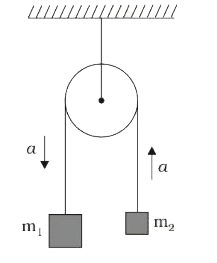Let mp be the mass of a proton , mn the mass of a neutron, M1 the mass of a .2010Ne nucleus and M2 the mass of a .4020Ca nucleus . Then
M2=M1
M2>M1
M2<2M1
M1<10(mn+mp)
The correct Answer is:d
To solve the problem, we need to analyze the masses of the nuclei of Neon and Calcium based on their constituent protons and neutrons.
1. Identify the Composition of the Nuclei:
- The nucleus of Neon-20 (2010Ne) consists of 10 protons and 10 neutrons.
- The nucleus of Calcium-40 (4020Ca) consists of 20 protons and 20 neutrons.
2. Calculate the Theoretical Masses:
- The theoretical mass of the Neon nucleus (M1) can be calculated as:
Mtheoretical1=10mp+10mn
- The theoretical mass of the Calcium nucleus (M2) can be calculated as:
Mtheoretical2=20mp+20mn
3. Consider Mass Defect:
- Due to the binding energy, the actual (experimental) mass of the nuclei is less than the theoretical mass. Therefore:
M1<Mtheoretical1andM2<Mtheoretical2
- This implies:
M1<10mp+10mnandM2<20mp+20mn
4. Comparison of Masses:
- Since both M1 and M2 are less than their respective theoretical masses, we can summarize:
M1<10mp+10mnandM2<20mp+20mn
- However, we cannot directly compare M1 and M2 or their multiples without additional information.
5. Conclusion:
- The relationship between the masses does not allow for a direct comparison of M1 and M2 or their multiples. Thus, the correct conclusion is that the mass of the Neon nucleus is less than its theoretical mass, and the same applies to the Calcium nucleus.
Final Answer:
The correct option is that M1<10mp+10mn and M2<20mp+20mn, but we cannot establish a direct relationship between M1 and M2.
- The nucleus of Neon-20 (2010Ne) consists of 10 protons and 10 neutrons.
- The nucleus of Calcium-40 (4020Ca) consists of 20 protons and 20 neutrons.
- The theoretical mass of the Neon nucleus (M1) can be calculated as:
Mtheoretical1=10mp+10mn
- The theoretical mass of the Calcium nucleus (M2) can be calculated as:
Mtheoretical2=20mp+20mn
- Due to the binding energy, the actual (experimental) mass of the nuclei is less than the theoretical mass. Therefore:
M1<Mtheoretical1andM2<Mtheoretical2
- This implies:
M1<10mp+10mnandM2<20mp+20mn
- Since both M1 and M2 are less than their respective theoretical masses, we can summarize:
M1<10mp+10mnandM2<20mp+20mn
- However, we cannot directly compare M1 and M2 or their multiples without additional information.
- The relationship between the masses does not allow for a direct comparison of M1 and M2 or their multiples. Thus, the correct conclusion is that the mass of the Neon nucleus is less than its theoretical mass, and the same applies to the Calcium nucleus.
The correct option is that M1<10mp+10mn and M2<20mp+20mn, but we cannot establish a direct relationship between M1 and M2.
Topper's Solved these Questions
- NUCLEIBOOK - NCERT FINGERTPS ENGLISHCHAPTER - NUCLEIEXERCISE - HOTS
7 Videos
- NUCLEIBOOK - NCERT FINGERTPS ENGLISHCHAPTER - NUCLEIEXERCISE - EXEMPLAR PROBLEMS
7 Videos
- MOVING CHARGES AND MAGNETISM BOOK - NCERT FINGERTPS ENGLISHCHAPTER - MOVING CHARGES AND MAGNETISM EXERCISE - Assertion And Reason
15 Videos
- PRACTICE PAPPERBOOK - NCERT FINGERTPS ENGLISHCHAPTER - PRACTICE PAPPEREXERCISE - Practice Paper 3
50 Videos
Similar Questions
If mp is the mass of proton. mn that of a neutron, M1 that of _(10)Ne20 nucleus and M2 that of _(20)Ca40 nucleus, then which of the following relations is//are not true?
View SolutionMp denotes the mass of a proton and Mn that of a neutron. A given nucleus, of binding energy B, contains Z protons and N neutrons. The mass M(N,Z) of the nucleus is given by.
View SolutionMp denotes the mass of a proton and Mn that of a neutron. A given nucleus, of binding energy B, contains Z protons and N neutrons. The mass M(N,Z) of the nucleus is given by.
View SolutionThe mass of a proton is 1836 times more than the mass of an electron. It a sub-atomic of mass (m)207 times the mass of electron is captured by the nucleus, then the first ionization potential of H:
View SolutionIf in a nuclear fusion process the masses of the fusing nuclei be m1 and m2 and the mass of the resuktant nucleus be m3, then
View SolutionIf in a nuclear fusion process the masses of the fusing nuclei be m1 and m2 and the mass of the resultant nucleus be m3, then
View SolutionCalculate the binding energy of an α-particle in MeV Given : mp (mass of proton) = 1.007825 amu, mn (mass of neutron) = 1.008665 amu Mass of the nucleus =4.002800 amu, 1 amu = 931 MeV.
View SolutionTwo bodies of masses m1andm2(<m1) are connected to the ends of a massless cord and allowed to move as shown in figure. The pulley is both massless and frictionless. The acceleration of the centre of mass is (m1−m2)n(m1+m2)2g. Find the value of n.

View SolutionThe mass of proton is 1.0073u and that of neutron is 1.0087u (u= atomic mass unit). The binding energy of .2He4 is (mass of helium nucleus =4.0015u)
View SolutionAll nuclei consist of two types of particles- protaon and neutrons. Nuclear force is the strongest froce. Stability of nucleus is determined by the neutron - proton ratio or mass defect or binding energy per nucleus or packing fraction. Shape of nucleus is calculated by quadrupole moment. Spin of nucleus depends on even or odd mass number. Volume of nucleus depends on the mass number. Whole mass of the atom (nearly 99%) is centered at the nucleus. Magnetic moment of the nucleus is measured in terms of the nuclear magnetons.
The correct statements about nuclear force is/are
View Solution
